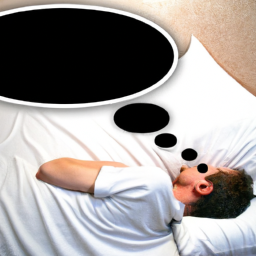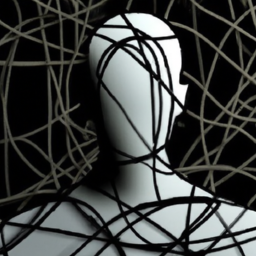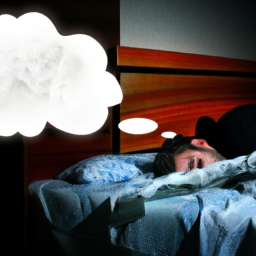Isn’t it fascinating how we can conjure up entire universes and scenarios in our minds while we sleep? Sometimes we wake up feeling like we just watched a movie, while other times we are left feeling confused and perplexed. But what’s the story with the people we encounter in our dreams? What is the significance of their presence?
As someone who has always been fascinated by dreams and their meanings, I’ve done some research and reflection on this topic. It’s interesting to me that dreams can feel so real yet be so abstract at the same time. The people we encounter in our dreams can range from complete strangers to loved ones who have passed away.
So why do they appear? Is it just our minds playing tricks on us, or is there a deeper meaning behind it all? In this article, I’ll be exploring various theories and ideas surrounding the appearance of people in our dreams, as well as sharing some personal insights and experiences.
Key Takeaways
- Dream characters can range from strangers to loved ones and can hold different levels of significance in dreams.
- Recurring dream characters may represent unresolved feelings towards them in waking life.
- Emotional triggers like unresolved conflicts, fears, and desires can manifest as dream characters and elicit psychological responses such as anxiety, joy, or sadness.
- Relationships in dreams can provide insight into our emotional and psychological needs, such as family and friends, romantic relationships, and professional relationships.
Theories Behind Dream Interpretation
You might be wondering what the heck your dreams mean, but don’t worry – there are plenty of theories out there to help you interpret them!
One of the most popular theories is dream symbolism, which suggests that the objects, people, and actions in your dreams represent aspects of your waking life. For example, dreaming of a snake could represent your fear of something in your life, while dreaming of flying could represent your desire for freedom or escape.
Dream analysis techniques can also be used to interpret your dreams. One such technique is called free association, where you write down everything you remember from your dream and then associate each element with a word or phrase that comes to mind.
Another technique is called amplification, where you explore the symbolic meanings of each element in your dream and then try to connect them to your waking life. Understanding these theories and techniques can help you better understand the meaning behind your dreams and the people who appear in them.
As you start to delve deeper into the world of dream interpretation, you’ll begin to notice the different types of dream characters that appear in your dreams. These characters can range from family members and friends, to complete strangers and fantastical creatures. So, let’s take a closer look at these types of dream characters and what they might mean.
Types of Dream Characters
When certain dream characters show up in your subconscious world, they can be as comforting as a warm blanket on a chilly night. These characters can be people you know, strangers, or even animals. However, not all characters hold the same significance in your dreams. Some characters serve as mere props, while others are essential to the plot of your dream. In fact, some characters may even recur in your dreams.
Understanding the symbolic meanings behind these recurring characters can provide insight into your subconscious mind. For instance, if you keep dreaming about a particular person, it may represent unresolved feelings towards them in your waking life. Alternatively, if you dream about a specific animal, it may indicate a particular personality trait or emotion you associate with that animal. The table below further illustrates the possible symbolic meanings behind some common types of dream characters.
| Character Type | Symbolic Meaning | Examples |
|---|---|---|
| Strangers | New opportunities, fear of the unknown | A stranger offering you a job |
| Famous People | Aspirations, desires | Meeting your celebrity idol |
| Animals | Personality traits, instincts | A lion symbolizing strength and courage |
| Deceased Loved Ones | Grief, longing | Seeing a deceased relative in your dream |
| Romantic Interests | Unresolved feelings, desires | Kissing someone you have a crush on |
Understanding the symbolic meanings behind these characters can help you interpret the message your subconscious is trying to communicate. However, it’s important to note that the interpretation of a dream character’s significance may differ from person to person. In the next section, we’ll explore the role of emotions in dream interpretation.
The Role of Emotions
When I dream, my emotions play a crucial role in shaping my experience. Positive emotions, such as joy and happiness, can make my dreams feel bright and hopeful.
On the other hand, negative emotions like fear or sadness can turn my dreams into a nightmare. Emotional triggers, such as stressful situations or unresolved feelings, can also influence the content of my dreams.
Understanding how emotions impact my dreams and how to process them can lead to a more fulfilling dream life.
Positive and Negative Emotions
Feeling positive or negative emotions can greatly impact the people who appear in your dreams. The emotions that we experience during our waking life can carry over into our dreams and influence the way we perceive the people and situations we encounter.
Here are some ways that positive and negative emotions can affect the people who appear in our dreams:
- Positive emotions can lead to more pleasant interactions with dream characters and may result in positive outcomes in the dream.
- Negative emotions can cause dream characters to behave in a hostile or unpleasant manner, leading to negative outcomes in the dream.
- Strong emotions, whether positive or negative, can make dream characters more memorable and vivid, making them more likely to appear in future dreams.
- Repressed emotions can manifest in dreams as unresolved conflicts with dream characters.
- Emotions can be explored through symbolism and interpretation techniques to gain insight into our subconscious thoughts and feelings.
Understanding how our emotions impact our dreams can help us gain a deeper understanding of ourselves and our emotional triggers.
In the next section, we’ll explore how emotional triggers can influence the people who appear in our dreams.
Emotional Triggers
By delving into the symbolism of our dreams, we can uncover emotional triggers that influence the individuals we encounter in our dreams. Common triggers that appear in dreams include unresolved conflicts, fears, and desires.
These triggers can manifest in the form of people we know or complete strangers, and they often elicit psychological responses such as anxiety, joy, or sadness.
For example, if I have unresolved conflict with a friend, I may dream about them in a negative light, which triggers feelings of anger or frustration. On the other hand, if I have a strong desire to reconnect with a loved one who has passed away, I may dream about them in a positive light, which triggers feelings of comfort or warmth.
By paying attention to these emotional triggers and exploring their underlying meanings, we can gain insight into our own subconscious and begin to process our emotions in a healthy way. This understanding of emotional triggers in dreams can lead to a better understanding of how we process emotions in our waking lives.
By exploring the symbolism and psychological responses in our dreams, we can learn how to better manage our emotions and develop healthier relationships with the people around us.
Emotional Processing
Exploring the ways in which our subconscious processes emotions during dreaming can provide us with valuable insights into our own emotional processing in waking life. During sleep, our brains continue to function and process information, including our emotions.
The neurological impact of dreaming allows for cognitive processing of emotions that may be difficult to confront during our waking hours. In fact, research suggests that dreaming helps us to regulate our emotions by providing a safe space to process them. This emotional processing can lead to personal growth and development, as we are able to confront and work through challenging emotions in a non-threatening environment.
Additionally, the insights gained from analyzing our dreams can help us better understand ourselves and our emotional patterns, allowing us to make more informed decisions and improve our relationships. Ultimately, exploring the emotional processing that occurs during dreaming can be a powerful tool for personal growth and self-discovery.
As we continue to explore the role of dreams in our emotional processing, it’s important to reflect on our own experiences and how they relate to the insights gained through dream analysis. Personal reflection and growth can be fostered by a willingness to confront uncomfortable emotions and a commitment to self-improvement.
By incorporating the lessons learned from our dreams into our daily lives, we can gain a deeper understanding of ourselves and our emotions, leading to greater fulfillment and happiness.
Personal Reflection and Growth
As I reflect on my dreams and their significance, I realize that they offer a unique opportunity for self-discovery, self-expression, and self-acceptance.
Through my dreams, I’m able to explore different aspects of my personality and subconscious thoughts that I may not be aware of in my waking life.
By analyzing and interpreting my dreams, I’m able to gain a deeper understanding of myself and my emotions, which can aid in personal growth and development.
Self-Discovery
Discovering who we are is like peeling back the layers of an onion, and sometimes the people who appear in our dreams can help us uncover a deeper understanding of ourselves. Through journaling techniques and meditation practices, I have been able to identify patterns in my dreams and connect them to my waking life experiences. By exploring the emotions and themes that arise in my dreams, I have gained a greater understanding of my own desires, fears, and motivations.
To further analyze the people who appear in my dreams, I have created a table to categorize their characteristics and how they relate to different aspects of my personality. By examining the traits of these dream characters, I have been able to gain insight into my own strengths and weaknesses. For example, if a dream character is particularly assertive, it may indicate that I need to work on being more confident in my waking life. On the other hand, if a dream character is passive, it may suggest that I need to be more assertive and take control of situations that I am facing.
As I continue to explore the people who appear in my dreams, I am discovering an even deeper understanding of myself. By using journaling and meditation as tools for self-discovery, I am able to connect with my subconscious mind and gain insight into my own thoughts and feelings. Through this process, I am able to identify areas where I need to grow and develop, and take steps towards becoming the best version of myself. In the next section, I will explore how self-expression can further enhance my personal growth and development.
Self-Expression
As I continue to explore my dreams and their significance, I’ve realized that self-expression plays a significant role in the people that appear in my dreams.
My subconscious mind is always searching for ways to express myself creatively, and this often manifests in the form of people who inspire me, challenge me, or encourage me to explore new forms of artistic expression.
Through creative visualization, I can tap into my subconscious mind and explore new ways to express myself through various art forms. For example, I may dream of a famous painter who inspires me to pick up a paintbrush and try my hand at painting. Alternatively, I may dream of a musician who encourages me to explore new sounds and melodies on my guitar.
These people in my dreams are not simply random characters, but rather they represent a part of myself that I’m trying to express creatively.
As I delve deeper into the significance of these dream characters, I realize that self-acceptance is a crucial step in my journey towards self-discovery.
Self-Acceptance
Embracing who you truly are, flaws and all, is the key to achieving self-acceptance and unlocking your full potential. It’s easy to get caught up in the idea of who we think we should be, based on societal expectations or our own self-imposed pressures. But the truth is, no one is perfect, and accepting our imperfections is the first step towards true self-acceptance.
Practicing mindfulness and self-compassion techniques can help us cultivate a deeper sense of self-awareness and self-love. Being mindful means being present in the moment and observing our thoughts and emotions without judgment. Self-compassion means treating ourselves with the same kindness and understanding that we would offer to a good friend. By incorporating these practices into our daily lives, we can learn to accept ourselves for who we are, and recognize that our worth is not determined by external factors such as our appearance or achievements.
As we continue on our journey towards self-acceptance, it’s important to acknowledge the influence that culture and society have on our sense of self. From a young age, we are bombarded with messages about what it means to be successful, beautiful, or worthy. These messages can be difficult to navigate, and it’s important to question their validity and consider how they align with our own values and beliefs.
The Influence of Culture and Society
When it comes to the influence of culture and society on our dreams, there are several key points to consider.
Firstly, cultural symbols and beliefs play a significant role in shaping our dreamscapes.
Secondly, the historical context of our society also impacts the content of our dreams.
Finally, social norms and expectations can influence how we interpret and react to our dreams.
Understanding these factors can provide valuable insights into the workings of our subconscious minds and the impact of our cultural and social environments on our overall wellbeing.
Cultural Symbols and Beliefs
You may find it interesting that the cultural symbols and beliefs you grew up with often manifest in your dreams, even if you don’t consciously think about them. Symbolic interpretation is a significant aspect of dream analysis, and it involves identifying the cultural symbols that appear in your dreams and interpreting their meanings.
Cross-cultural analysis of these symbols can also provide a deeper understanding of your dreams and help you gain insight into your psyche.
For instance, if you grew up in a culture where the snake is considered a symbol of evil, and you dream about a snake, it could symbolize danger or threat. However, if you grew up in a culture where the snake is considered a symbol of wisdom or rebirth, the same dream could represent a positive transformation.
By understanding the cultural symbols present in your dreams, you can decode their meanings and find hidden messages that your subconscious is trying to convey. This can help you make better decisions in your waking life and gain a deeper understanding of yourself and your cultural identity.
As we delve deeper into the topic of dream analysis, it’s essential to consider the historical context that informs our understanding of dreams. Understanding the cultural and historical influences that shaped our beliefs about dreams can provide insight into why we dream the way we do.
Historical Context
In the previous subtopic, we explored how cultural symbols and beliefs can influence the people and objects that appear in our dreams. However, it’s important to note that the cultural significance of certain symbols and beliefs has evolved over time due to historical context.
When we examine the artistic representations of dreams throughout history, we can see how the people and objects that appear in our dreams have shifted in cultural significance.
For example, in ancient Egyptian culture, dreams were seen as direct messages from the gods, and the people and objects that appeared in them were seen as divine omens. In contrast, during the Renaissance period in Europe, dreams were seen as a product of the imagination, and the people and objects that appeared in them were often interpreted symbolically.
By examining the historical context of dreams, we can gain a deeper understanding of the cultural significance of the people and objects that appear in them.
As we move into the next section about social norms and expectations, it’s important to keep in mind how cultural context can shape our dreams. Our dreams can reveal unconscious thoughts and desires, but they’re also shaped by our social and cultural environments.
Let’s explore how social norms and expectations can influence the people and objects that appear in our dreams.
Social Norms and Expectations
By examining how social norms and expectations influence the symbols and themes in our dreams, we can gain insight into the unconscious pressures and desires of our waking lives. Our dreams often reflect the social pressure and cultural norms that we experience in our daily lives. For example, if we have been raised in a culture that values success and achievement, we may dream of winning a race or receiving an award. Similarly, if we feel pressured to conform to certain social norms, such as having a certain body type or dressing a certain way, these expectations may manifest in our dreams.
To further understand the influence of social norms on our dreams, consider the following table:
| Dream Symbol | Social Norms/Pressure |
|---|---|
| Falling | Fear of failure |
| Being chased | Pressure to meet deadlines |
| Losing teeth | Fear of aging |
| Being naked in public | Fear of judgement |
This table shows how our dreams can be influenced by the social norms and pressures that we experience in our waking lives. By analyzing our dreams through this lens, we can gain a deeper understanding of the unconscious desires and fears that drive our behaviors and decisions.
Our dreams are not just random occurrences, but rather reflections of our experiences and internal thoughts. By examining the influence of social norms and expectations on our dreams, we can gain insight into our unconscious desires and anxieties. This understanding can help us navigate our waking lives with greater awareness and purpose. Moving forward, we will discuss the significance of relationships in our dreams, and how they can provide insight into our emotional and psychological needs.
The Significance of Relationships
As I explore the significance of relationships in dreams, three key areas come to mind: family and friends, romantic relationships, and professional relationships.
These relationships can often have a profound impact on our waking lives, and it makes sense that they would also manifest in our dreams.
Dreaming about a loved one can elicit strong emotions and provide insight into our subconscious feelings and desires.
Similarly, dreaming about a colleague or boss can reveal underlying tensions or ambitions in our professional lives.
Overall, the significance of relationships in dreams highlights the importance of our connections with others and the ways in which they shape our experiences.
Family and Friends
When you dream about your family and friends, your subconscious mind may be processing unresolved emotions or experiences related to those individuals. Family dynamics and childhood memories can have a significant impact on how we view ourselves and our relationships with others.
Dreams about family and friends may be an opportunity to explore these dynamics and memories in a safe and controlled environment. They can also reveal our underlying emotions and feelings towards these individuals. For example, if we dream about a family member who has passed away, it may be a sign that we’re still processing our grief and loss.
Similarly, if we dream about a friend who we have lost touch with, it may be a sign that we miss their presence in our lives. Understanding the significance of these dreams can help us to better understand our own emotions and relationships with those around us.
With that said, dreams about family and friends are just one aspect of our subconscious mind, and they’re often intertwined with dreams about romantic relationships.
Romantic Relationships
Imagine you’re lost in a maze of mirrors, searching for the perfect reflection of yourself in a romantic partner, but each reflection is distorted and incomplete, leaving you feeling frustrated and alone.
Dreams about romantic relationships can be just as confusing and unsatisfying. They can leave you feeling jealous, longing for a past relationship, or even questioning your current relationship status. But why do we dream about our romantic relationships?
Perhaps it’s because our subconscious mind is trying to process unresolved emotions or conflicts within the relationship. Dreams can serve as a way for our minds to work through issues that we may not have fully addressed while awake.
Additionally, dreaming about an ex-partner could be a sign that we still have unresolved feelings or unfinished business with that person. Our dreams may be trying to bring attention to these issues in order for us to finally move on and find closure.
As we navigate the maze of our romantic relationships in our dreams, it’s important to remember that they are often a reflection of our innermost thoughts and emotions. By paying attention to these dreams and the feelings associated with them, we can gain valuable insights into ourselves and our relationships.
And as we move on to the next section about professional relationships, we can apply this same level of introspection and growth to our work lives.
Professional Relationships
Navigating professional relationships can be challenging, but you can use the insights gained from your dreams about romantic relationships to grow and improve in your work life. Dreams about professional relationships can reveal a lot about the power dynamics and communication styles at play in your workplace. It’s important to pay attention to these dreams and use them as a tool for self-reflection and improvement.
To better understand the insights that dreams can provide about professional relationships, consider the following table:
| Dream Symbol | Interpretation | Action to Take |
|---|---|---|
| A boss or authority figure | Power dynamics | Assess if there is a power imbalance and work to address it |
| Communication breakdown | Communication styles | Evaluate your own communication style and make adjustments if necessary |
| Conflict with a coworker | Interpersonal relationships | Try to identify the root cause of the conflict and work towards resolution |
By analyzing your dreams and taking action based on the insights gained, you can improve your relationships and communication with colleagues, leading to a more positive and productive work environment. Remember, your dreams are a powerful tool for self-reflection and growth, even in your professional life.
Transitioning into the next section about the power of the unconscious mind, it’s important to continue to pay attention to your dreams and use them as a tool for personal and professional development. By tapping into the insights and wisdom of your unconscious mind, you can gain a deeper understanding of yourself and the world around you.
The Power of the Unconscious Mind
I believe that one of the most fascinating aspects of the human mind is its ability to process information on both conscious and unconscious levels.
When it comes to dreaming, the power of the unconscious mind becomes even more apparent, as it’s responsible for generating the images, thoughts, and emotions that we experience during sleep.
I find it intriguing how subliminal messages, hidden desires and fears, and unresolved issues can all manifest themselves in our dreams. This provides us with valuable insights into our own psyche.
Subliminal Messages
You may not realize it, but your subconscious mind is constantly picking up on subliminal messages throughout the day, which can manifest in your dreams and lead to the appearance of certain people. These messages can come from various sources, such as subliminal advertising or even dream manipulation by your own mind.
To better understand how subliminal messages can affect your dreams, let’s look at the following table:
| Subliminal Message | Possible Dream Manifestation |
|---|---|
| Hearing a certain song repeatedly | Dreaming about the artist or a related event |
| Seeing a particular brand logo | Dreaming about the brand or related products |
| Receiving a compliment | Dreaming about the person who gave it or a similar scenario |
As you can see, the subconscious mind can interpret subliminal messages in various ways and manifest them in your dreams. This is why it’s important to be aware of the messages you are exposed to throughout the day and how they may affect your thoughts and dreams.
Moving forward, it’s important to recognize that subliminal messages are just one factor that can influence the people who appear in your dreams. Hidden desires and fears can also play a significant role and we will explore this aspect in the next section.
Hidden Desires and Fears
If you’re not careful, unresolved desires and fears can creep into your dreams, shaping them into strange and unsettling scenarios that leave you feeling uneasy upon waking.
Dreams are often a reflection of our unconscious mind, and they can provide insight into our deepest desires and fears.
By exploring our subconscious through psychological interpretation of our dreams, we can gain a better understanding of ourselves and the unresolved issues that may be affecting our daily lives.
Dreams can be a gateway to our innermost thoughts and emotions. They can reveal our anxieties, insecurities, and unfulfilled wishes.
By analyzing the symbols and themes that appear in our dreams, we can gain a deeper understanding of our subconscious and the issues that we may need to address.
However, it’s important to approach dream analysis with caution, as it’s not always easy to interpret the meaning behind our dreams.
Nonetheless, by taking the time to explore our subconscious through our dreams, we can gain valuable insights into our inner selves, helping us to better understand and address any unresolved issues that may be holding us back.
Unresolved Issues
Unresolved issues can manifest in our dreams, often appearing in symbolic forms that may be difficult to decipher without careful analysis. As the subconscious mind tries to process unresolved emotions, it creates a dream world where these emotions can be explored and hopefully resolved.
For instance, dreaming about a lost loved one may indicate that we’re still grappling with the pain of their passing. The emotions and memories that we have buried deep within us can surface during our dreams, giving us a chance to work through them and find closure.
Addressing unresolved issues in dreams can be an effective form of therapy, allowing us to access our subconscious mind and facilitate the healing process. Through dream analysis, we can bring to light the underlying emotions and experiences that have been holding us back, allowing us to confront them head-on.
By acknowledging and processing these emotions, we can move forward with a greater sense of clarity and inner peace. As we continue to work through our unresolved issues, we may find that our sleep patterns improve, and we wake up feeling more refreshed and energized each day.
The Connection to Sleep Patterns
I find it fascinating how our sleep patterns can affect our dreams. Research has shown that REM sleep, the stage of sleep when we dream, is essential for our brain’s health and function.
Sleep deprivation can lead to more vivid and emotionally charged dreams, while sleep disorders such as sleep apnea and narcolepsy can also impact the content and frequency of our dreams.
Understanding the connection between our sleep patterns and dreaming may provide insight into the importance of sleep for our overall well-being.
REM Sleep and Dreaming
During REM sleep, your brain is most active, causing vivid and often bizarre dreams that can feature people from your past, present, and even your imagination. This stage of sleep is characterized by rapid eye movements, increased heart rate, and shallow breathing.
While we may not always remember our dreams, they play an important role in our overall mental and emotional wellbeing. The benefits of REM sleep go beyond just dreaming. It has been shown to play a crucial role in memory consolidation, which is the process of strengthening and organizing memories.
During this stage of sleep, the brain is able to sort through and store memories, making them easier to access and recall in the future. Additionally, REM sleep has been linked to the regulation of mood and emotions, making it an important factor in mental health.
As we continue to explore the complexities of the human brain, the importance of REM sleep and dreaming continues to be a fascinating area of research. Moving forward, it’s important to understand the connection between sleep and mental health, including the effects of sleep deprivation on dreaming.
Sleep Deprivation and Dreaming
Lack of sleep can leave you feeling like you’re stuck in a foggy haze, with dreams that are disjointed and surreal. Sleep deprivation can mess up the natural cycle of Rapid Eye Movement (REM) sleep, which is the stage where most dreaming occurs. As a result, dreams may become more vivid, intense and bizarre when you don’t get enough sleep. It’s not uncommon to experience nightmares, recurring dreams or even hallucinations when you’re sleep-deprived.
But it’s not just the lack of sleep that can impact your dreams. The relationship between exercise and dreaming has also been studied. Regular physical activity has shown to improve sleep quality, which may lead to clearer and more positive dreams. On the other hand, consuming caffeine close to bedtime can disrupt sleep and lead to more fragmented and less restful sleep, which can also affect the quality of your dreams.
Moving on to the next section about sleep disorders and dreaming, it’s important to note that sleep deprivation and other sleep disturbances can have a significant impact on mental and physical health.
Sleep Disorders and Dreaming
As I mentioned earlier, sleep deprivation can have a significant impact on the way we dream. However, there are also specific sleep disorders that can affect our dreams.
One of the most well-known sleep disorders that impact dreaming is REM sleep disorder. This disorder occurs when the body doesn’t properly enter into a state of paralysis during REM sleep, which can result in physically acting out dreams. This can be dangerous for both the individual experiencing the disorder and those around them.
On the other hand, there are also techniques that individuals can use to actively control and manipulate their dreams. These techniques, known as lucid dreaming techniques, allow individuals to become aware that they’re dreaming and even influence the contents of their dreams. Some individuals use these techniques for therapeutic purposes, while others simply enjoy the freedom and creativity that comes with lucid dreaming.
Speaking of the science behind dreaming, there have been numerous studies and findings that shed light on the reasons why certain people appear in our dreams.
Scientific Studies and Findings
You’ll be fascinated to learn that scientific studies and findings suggest that people appear in your dreams for a variety of reasons. Here are three key ways in which they can show up:
-
Processing emotions and memories – Dreams often serve as a way for your brain to process and work through emotional experiences and memories from your waking life. By bringing people from your past or present into your dreams, your brain can continue to work through these experiences in a safe and controlled environment.
-
Problem-solving – Dreams can also serve as a way for your brain to problem-solve and come up with creative solutions to challenges you may be facing. By bringing people into your dreams who represent different aspects of yourself or your situation, your brain can explore different perspectives and come up with new ideas.
-
Exploring your unconscious mind – Finally, people can appear in your dreams as a way for your unconscious mind to explore and express itself. Dream symbolism and dream analysis techniques can help uncover deeper meanings and messages that your brain may be trying to communicate through the appearance of certain people or scenarios in your dreams.
By understanding these reasons why people appear in your dreams, you can gain a deeper insight into your own thoughts, feelings, and experiences. As you continue to explore your dreams and their meanings, you may find new ways to understand and navigate your waking life with greater clarity and purpose.
Frequently Asked Questions
Can certain foods or activities affect the likelihood of dreaming about certain people?
I’ve always wondered if my diet and exercise affect who I dream about. After some research, it turns out that what we eat and how we move can impact the people we see in our dreams. Fascinating, right?
Why do some people appear in dreams more frequently than others?
Some people appear in my dreams more frequently than others. This could be due to nature vs nurture – genetic or environmental factors influencing my subconscious. Psychological imprinting also plays a role, as past experiences shape my dreams.
Are dreams really a reflection of our subconscious desires and fears?
Dreams can reveal our subconscious desires and fears, according to psychoanalytic theories. Lucid dreaming allows us to consciously access and explore our innermost thoughts, providing insight and understanding of ourselves.
Can dreams be used as a tool for predicting the future or gaining insight into past events?
Dream analysis and lucid dreaming can provide insight into past experiences and emotions. While not a tool for predicting the future, they offer a unique perspective for self-reflection and growth. With practice, one can harness the power of their dreams for personal development.
Do people who appear in our dreams have any influence over our waking lives?
People who appear in our dreams may have a significant impact on our waking lives. Dream interpretation and lucid dreaming can help us understand these connections and provide valuable insights for personal growth and development.
Conclusion
In conclusion, after delving into the various theories behind dream interpretation, it’s clear that there are a multitude of factors that contribute to the appearance of certain people in our dreams.
From the role of emotions and personal growth to the influence of culture and society, every dream character can hold significant meaning. The power of the unconscious mind can’t be ignored, as it often reveals deep-seated desires and fears that we may not even be aware of.
Furthermore, scientific studies have shown that our sleep patterns play a crucial role in the content of our dreams. The brain is highly active during REM sleep, and it’s during this time that our dreams are most vivid and memorable.
As the saying goes, "you are what you dream,"and it’s important to pay attention to the messages our dreams may be trying to convey. By understanding the significance of the people who appear in our dreams, we can gain valuable insight into our own psyche and lead a more fulfilling life.










